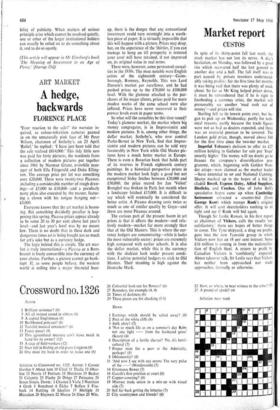A hedge, backwards
ART MARKET FLORENCE PLACE
`Your reaction to the sale?' the narrator in- quired, as colour-television cameras panned in on the unnaturally pink face of Mr Peter Wilson, chairman of Sotheby's, on 23 April. `Relief,' he replied : 'I have just been told that the sale realised £814,000.' This tidy little sum was paid for forty pictures, the weedouts from a collection of modern pictures put together since 1961 by Norman Granz, erstwhile man- ager of both Ella Fitzgerald and Duke Elling- ton. The average price per lot was something over £20,000. There were twenty-two Picassos, including a considerable number of rough draw- ings—at £5,000 to £10,000—and a peculiarly nasty plate also executed by the master, featur- ing a clown with his tongue hanging out— £3,000.
Everyone knows that the art market is boom- ing. But something decidedly peculiar is hap- pening this spring. Picasso prices appear already to be some 20 to 30 per cent above last year's level—and last year's level was by no means low. There is no doubt that in these dark and dangerous times art is being bought not so much for art's sake but as a currency hedge.
The logic behind this is simple. The art mar- ket is truly international—a Picasso or a Rem- brandt is freely convertible into the currency of your choice. Further, a picture cannot go bank- rupt. If, as some people believe, the western world is rolling into a major financial bust-
up, there is the danger that any conventional investment could turn overnight into a worth- less piece of paper. It is virtually impossible that this will happen with a picture. Prices may drop, but, on the experience of the 'thirties, if you can manage to hang on till prosperity is restored your asset will have retained, if not improved on, its original value in real terms.
There were, however, some permanent casual- ties in the 1930s. The most notable were English artists of the eighteenth century—Gains- borough, Romney, Reynolds. This was Lord Duveen's market par excellence, and he had pushed prices up to the £70,000 to £100,000 level. With the glamour attached to the pur- chases of his major clients, prices paid for more modest works of the same school were also inflated. Prices have never recovered to their prewar levels even in paper terms.
So what will the casualties be this time round? Today's glamour market, the market where big money congregates, is in Impressionist and modern pictures. It is, among other things, the dollar market. Sotheby's, who now control Parke-Bernet in New York, find that Impres- sionist and modern pictures can be sold very favourably in New York while Old Master pic- tures have a much better market in Europe. There is even d Bavarian bank that holds part of its reserves in French eighteenth century paintings. In a historical perspective prices in the modern market look high; a good but not exceptional Sisley fetches between £20,000 and £30,000; the price record for Jan 'Velvet' Breughel was broken in Paris last month when a landscape fetched £15,000. It is difficult to say which will eventually be considered the better artist. A Picasso drawing costs twice as much as one of similar quality by Goya—and there are more Picassos around.
The curious part of the present boom in art prices is that it affects the modern—and rela- tively modern—market far more strongly than that of the Old Masters. This is where the cur- rency hedgers are concentrating—while it looks the most vulnerable sector: prices are extremely high compared with earlier schools. It is also the dollar market, while this is the currency with the shakiest look under present condi- tions. I advise potential hedgers to stick to Old Masters. Their standing is high against the Deutsche Mark.






































 Previous page
Previous page